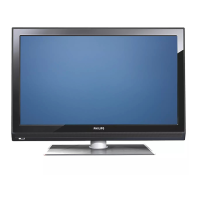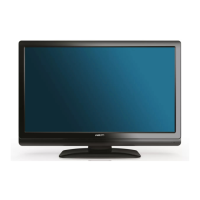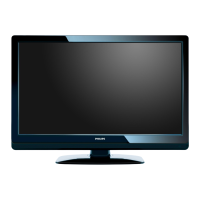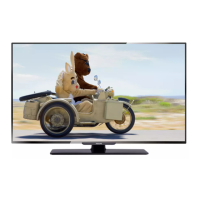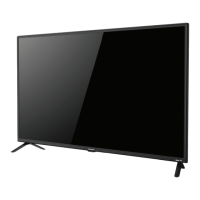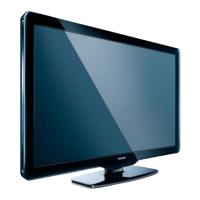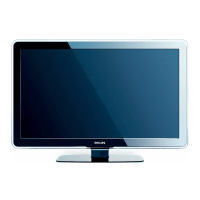Do you have a question about the Philips 42OLED808 and is the answer not in the manual?
Explains the process to protect the screen and refresh the OLED TV over time.
Provides recommendations for taking care of the OLED TV to prevent image retention.
Explains the Dashboard panel, its access methods, and features.
Details the differences between Google TV mode and Basic Mode.
Advises reading safety instructions before using the TV.
Provides information on installing the TV stand or wall mounting bracket.
Instructions for connecting the power cable.
Details the function of each key on different types of remote controls.
Explains how to pair the remote control with the TV via Bluetooth.
Explains how to use voice search via the remote control.
How to turn the TV on, put it in standby, and reboot it.
Detailed guide on installing satellite channels.
Instructions for updating channels from antenna sources.
How to perform a factory reset for a full TV reinstallation.
How to tune to channels, switch, and use previous channel.
How to lock/unlock channels and set parental ratings.
Information on HDMI ports, quality, and HDCP copy protection.
Details on HDMI ARC and eARC connections for audio.
How to connect a computer for use as a PC monitor.
How to connect the TV to a home network and the Internet.
How to sign in and use your Google Account for TV features.
How to start and use the TV's internet browser.
How to switch between connected devices and TV tuners.
How to access TV functions and settings quickly.
Overview of picture settings and AI Picture Styles.
Overview of sound styles, personal settings, and equalizer.
How to select audio output (TV speakers, HDMI system, Play-Fi).
How to turn Ambilight on or off.
How to set Ambilight to follow video, audio, or colour.
How to rent/buy movies and TV shows from Google Play.
How to manage installed apps for performance.
Overview of accessibility features like high contrast text and text-to-speech.
Information about system software updates from internet or USB.
Settings for power on behavior and energy saving.
How to restart the TV for performance issues.
How to pair, connect, and operate Bluetooth devices.
How to pair and get information about the remote control.
How to view media files from a USB drive.
How to open video folders and play videos.
How to open music folders and play music.
How to download and use the Philips TV Remote App.
How to connect and play games from consoles or computers.
How to open and use the Netflix app.
How to set up and use Alexa voice control.
List of TV side and bottom connectivity ports.
Technical specifications for sound output and features.
How to access and use the TV's built-in Help system.
How to run TV diagnose and self-diagnose for troubleshooting.
Solutions for common problems like no picture, no sound, or remote control issues.
Important safety instructions to prevent electric shock, fire, or injury.
Guidelines for cleaning and caring for the TV screen.
General terms of use for the TV product.
Trademarks related to Google TV.
HDMI trademark information.
Explains the process to protect the screen and refresh the OLED TV over time.
Provides recommendations for taking care of the OLED TV to prevent image retention.
Explains the Dashboard panel, its access methods, and features.
Details the differences between Google TV mode and Basic Mode.
Advises reading safety instructions before using the TV.
Provides information on installing the TV stand or wall mounting bracket.
Instructions for connecting the power cable.
Details the function of each key on different types of remote controls.
Explains how to pair the remote control with the TV via Bluetooth.
Explains how to use voice search via the remote control.
How to turn the TV on, put it in standby, and reboot it.
Detailed guide on installing satellite channels.
Instructions for updating channels from antenna sources.
How to perform a factory reset for a full TV reinstallation.
How to tune to channels, switch, and use previous channel.
How to lock/unlock channels and set parental ratings.
Information on HDMI ports, quality, and HDCP copy protection.
Details on HDMI ARC and eARC connections for audio.
How to connect a computer for use as a PC monitor.
How to connect the TV to a home network and the Internet.
How to sign in and use your Google Account for TV features.
How to start and use the TV's internet browser.
How to switch between connected devices and TV tuners.
How to access TV functions and settings quickly.
Overview of picture settings and AI Picture Styles.
Overview of sound styles, personal settings, and equalizer.
How to select audio output (TV speakers, HDMI system, Play-Fi).
How to turn Ambilight on or off.
How to set Ambilight to follow video, audio, or colour.
How to rent/buy movies and TV shows from Google Play.
How to manage installed apps for performance.
Overview of accessibility features like high contrast text and text-to-speech.
Information about system software updates from internet or USB.
Settings for power on behavior and energy saving.
How to restart the TV for performance issues.
How to pair, connect, and operate Bluetooth devices.
How to pair and get information about the remote control.
How to view media files from a USB drive.
How to open video folders and play videos.
How to open music folders and play music.
How to download and use the Philips TV Remote App.
How to connect and play games from consoles or computers.
How to open and use the Netflix app.
How to set up and use Alexa voice control.
List of TV side and bottom connectivity ports.
Technical specifications for sound output and features.
How to access and use the TV's built-in Help system.
How to run TV diagnose and self-diagnose for troubleshooting.
Solutions for common problems like no picture, no sound, or remote control issues.
Important safety instructions to prevent electric shock, fire, or injury.
Guidelines for cleaning and caring for the TV screen.
General terms of use for the TV product.
Trademarks related to Google TV.
HDMI trademark information.
| Screen shape | Flat |
|---|---|
| Response time | - ms |
| Display diagonal | 42 \ |
| Display brightness | - cd/m² |
| Display technology | OLED |
| Native aspect ratio | 16:9 |
| Native refresh rate | 120 Hz |
| Supported video modes | 576p, 720p |
| Display diagonal (metric) | 106 cm |
| Supported graphics resolutions | 640 x 480 (VGA), 1920 x 1080 (HD 1080), 2560 x 1440, 3840 x 2160 |
| Display refresh rates supported | 24 Hz, 25 Hz, 30 Hz, 50 Hz, 60 Hz, 100 Hz, 120 Hz |
| Motion interpolation technology | - |
| Tuner type | Digital |
| Digital signal format system | DVB-C, DVB-S, DVB-S2, DVB-T, DVB-T2, DVB-T2 HD |
| Music apps | YouTube Music |
| Video apps | Amazon Prime Video, Apple TV, BBC iPlayer, Disney+, Netflix, YouTube |
| Smart modes | Filmmaker, IMAX Enhanced |
| Lifestyle apps | Google Apps |
| App distribution platform | Google Play |
| Operating system installed | Google TV |
| Sound modes | AI Sound |
| Audio decoders | DTS, Dolby Atmos, Dolby Digital, DTS:X, Dolby MS12 |
| RMS rated power | 50 W |
| Number of speakers | 2 |
| Audio output channels | 2.1 channels |
| Wi-Fi standards | Wi-Fi 5 (802.11ac) |
| Bluetooth version | 5.0 |
| Stand type | Center stand |
| Product color | Black |
| Panel mounting interface | 300 x 300 mm |
| Game features | Auto Low Latency Mode (ALLM), HGiG, Variable Refresh Rate (VRR) |
| Processor cores | 4 |
| AMD FreeSync type | FreeSync Premium |
| Teletext standards | Hyper-text |
| Audio formats supported | AAC, FLAC, MP3, WAV, WMA, WMA-PRO |
| Image formats supported | BMP, GIF, HEIF, JPEG, PNG |
| Video formats supported | AVC, AVI, H.264, HEVC/H.265, MKV, MPEG1, MPEG2, MPEG4, VP9 |
| Subtitle formats supported | ASS, SMI, SRT, SSA, SUB, TXT |
| Picture processing technology | Philips P5 Perfect Picture Engine |
| High Dynamic Range (HDR) technology | Dolby Vision, High Dynamic Range 10 (HDR10), High Dynamic Range 10+ (HDR10 Plus), High Dynamic Range 10+ Adaptive (HDR10 Plus Adaptive), Hybrid Log-Gamma (HLG) |
| USB 2.0 ports quantity | 3 |
| Ethernet LAN (RJ-45) ports | 1 |
| AC input voltage | 220 - 240 V |
| AC input frequency | 50/60 Hz |
| Energy efficiency scale | A to G |
| Power consumption (standby) | 0.3 W |
| Power consumption (typical) | - W |
| Cables included | AC |
| Package type | Box |
| Package depth | 160 mm |
| Package width | 1100 mm |
| Package height | 711 mm |
| Package weight | 17500 g |
| Battery type | AAA |
| Ambient lighting type | 3-sided |
| Internal memory | 16000 MB |
| Stand width | 400 mm |
|---|---|
| Depth (with stand) | 218 mm |
| Width (with stand) | 932 mm |
| Height (with stand) | 606 mm |
| Weight (with stand) | 15000 g |
| Depth (without stand) | 70 mm |
| Height (without stand) | 541 mm |
| Weight (without stand) | 12600 g |


